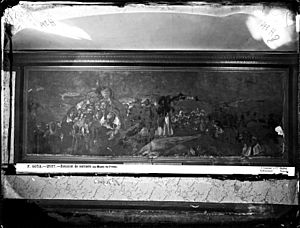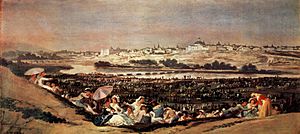A Pilgrimage to San Isidro facts for kids
Quick facts for kids A Pilgrimage to San Isidro |
|
|---|---|
| Spanish: La romería de San Isidro | |

Photo of the wall of the old house of Goya, taken by J. Laurent in 1874.
|
|
| Artist | Francisco Goya |
| Year | 1819–1823 |
| Medium | Oil mural transferred to canvas |
| Dimensions | 140 cm × 438 cm (55 in × 172 in) |
| Location | Museo del Prado, Madrid |
A Pilgrimage to San Isidro (Spanish: La romería de San Isidro) is a famous painting by Francisco de Goya. He painted it between 1819 and 1823. It is part of a special group of works called the Black Paintings.
Goya painted these works directly onto the walls of his house. His house was known as Quinta del Sordo, which means "The House of the Deaf Man". This painting was likely on a wall on the first floor. It was probably across from another famous painting, The Great He-Goat.
From Wall to Museum
Like Goya's other Black Paintings, A Pilgrimage to San Isidro was moved. This happened in 1873–74. The paintings were carefully taken from the walls and put onto canvas. This difficult job was overseen by Salvador Martínez Cubells. He was a curator at the Museo del Prado.
Later, the owner, Baron Emile d'Erlanger, gave the canvases to the Spanish government in 1881. Today, you can see them at the Museo del Prado in Madrid.
What the Painting Shows
A Pilgrimage to San Isidro shows a pilgrimage, which is a journey to a holy place. This pilgrimage was to San Isidro's Hermitage in Madrid. Goya had painted this same event about 30 years earlier. That earlier painting, The Meadow of San Isidro, showed a happy, traditional holiday.
However, this later painting is very different. It shows a group of people at night. Their faces are twisted, and they seem to be singing. The painting includes people from different parts of society. In the front, there are people who look humble. Further back, you can see top hats and nuns' clothes.
Goya used the idea of a procession to show something theatrical or even funny. It is similar to his painting The Burial of the Sardine. Some people think the procession in this painting might even be heading towards Goya's own house. It's like they are entering his imagination.
Goya's Style and Colors
Goya often painted crowds that seem to disappear into the distance. You can see this in San Isidro's Meadow. He also used this idea often in his series The Disasters of War. In A Pilgrimage to San Isidro, the shapes of the rocks and the marching crowd blend together. This makes the people look like a shapeless group. They lose their individual identities. Only one person on the right has a clear face. They seem to be moaning or singing.
Like the other Black Paintings, this painting uses very few colors. Goya mainly used blacks, browns, grays, and earthy tones. He used quick, strong brushstrokes. The idea of people losing their identity in a crowd was very new for its time. It can be seen as an early example of expressionist art. This style later became important in art, especially in the work of artists like James Ensor.
See also
 In Spanish: La romería de San Isidro para niños
In Spanish: La romería de San Isidro para niños
- List of works by Francisco Goya



